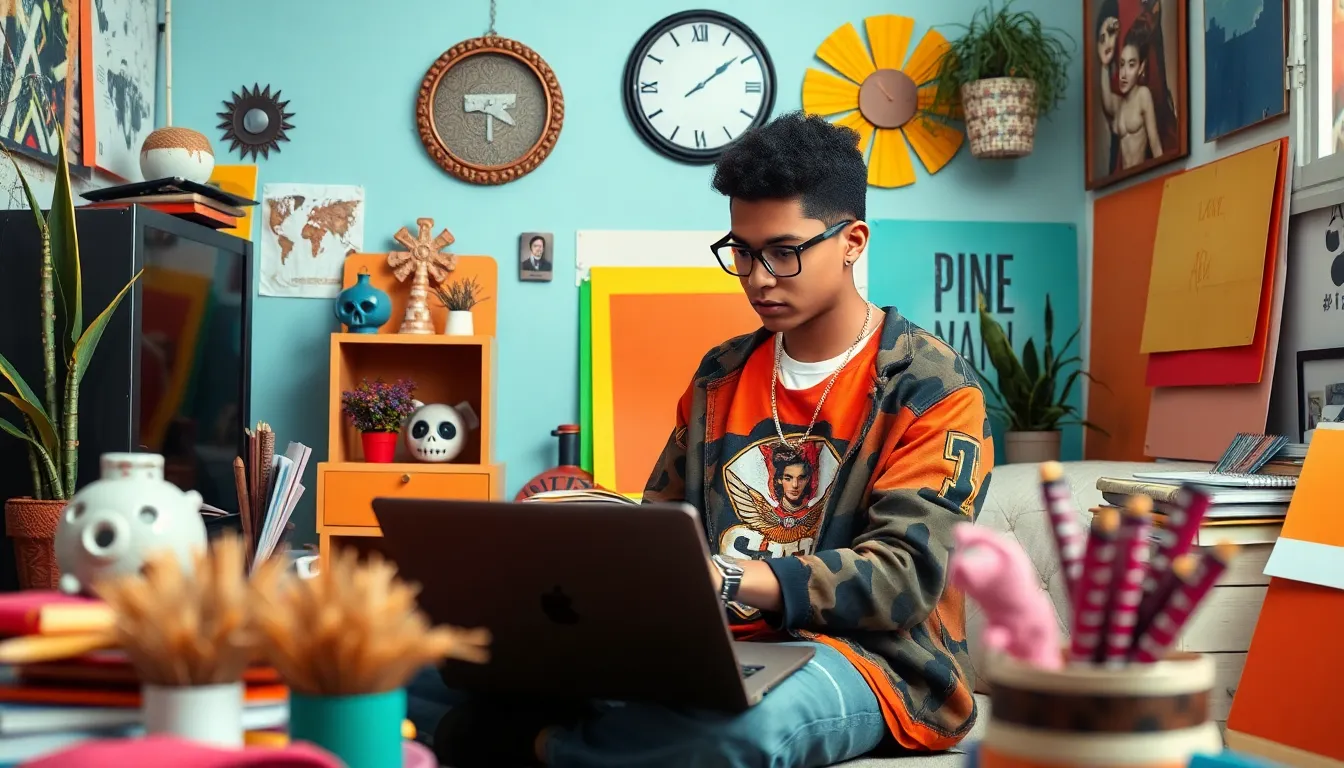Table of Contents
ToggleGen Z is shaking up the design world like a TikTok dance challenge. With a unique blend of nostalgia, bold colors, and a sprinkle of social consciousness, this generation isn’t just following trends—they’re redefining them. From quirky typography to eco-friendly materials, their design choices reflect a desire for authenticity and connection.
Overview of Gen Z Design Trends
Generation Z influences design through unique characteristics and bold choices. Nostalgia plays a significant role, with designs often featuring retro elements from the ’90s and early 2000s. Vibrant colors dominate this aesthetic, contrasting sharply with the muted palettes favored by previous generations.
Developing authenticity remains crucial for Gen Z designers. They prioritize personal expression over conformity, opting for eclectic styles and customizations that reflect individual identities. Quirky typography stands out as a favored design element, adding personality and playfulness to their projects.
Sustainability also shapes these design trends. Many Gen Z creators focus on eco-friendly materials, striving for designs that reflect their values. Ethical considerations impact choices, leading to an increase in upcycled products and sustainable practices within the design community.
Collaboration is common among Gen Z designers. They engage with peers and their audience through social media, fostering a sense of community and shared creativity. User-generated content becomes essential, as designs evolve based on feedback and relationships built online.
Minimalism still resonates, but Gen Z redefines it. They incorporate intentional clutter, layering visual elements to convey stories and emotions. This approach gives depth and dimension, distinguishing their work from previous minimalist trends.
Engagement with social issues influences design choices significantly. Designs often address mental health, inclusivity, and environmental activism, reflecting the values that resonate with their generation. Through their work, they aim to inspire action and raise awareness about critical topics.
Key Characteristics of Gen Z Aesthetics

Generation Z’s design aesthetic showcases bold elements that resonate with their values and personality. A significant part of this aesthetic involves vibrant colors and unique palettes that stand out.
Bold Colors and Unique Palettes
Bright shades define Gen Z’s art and design styles. These colors evoke energy and excitement, creating eye-catching visuals that attract attention. Pastels frequently combine with neon tones, producing unorthodox combinations that express individuality. Designers often draw inspiration from diverse cultural backgrounds, resulting in eclectic palettes that emphasize personal identity. Color placement often breaks conventions, making it a crucial tool for storytelling in their designs.
Minimalism Meets Maximalism
This generation redefines minimalism through the lens of maximalism. Intentional clutter and unique layering of elements add depth and interest to their work. While traditional minimalism favors simplicity, Gen Z embraces complexity to convey narratives and emotions. The rhythm of patterns, textures, and colors in their designs creates harmonious chaos. Significantly, this approach reflects their multifaceted identities and the rich tapestry of their experiences, blending simplistic ideas with vibrant flair.
Popular Design Styles Among Gen Z
Generation Z embraces diverse design styles that merge nostalgia with innovation. Their choices reflect personal identity and social consciousness.
Retro and Vintage Influences
Nostalgia significantly shapes Gen Z’s design aesthetic. Elements from the ’90s and early 2000s consistently appear in various projects. Vibrant colors and quirky typography draw inspiration from past trends. Designers often incorporate vintage graphics and retro color schemes to evoke familiar feelings. These choices create a sense of connection among viewers. Furthermore, Gen Z artists value unique items like thrifted and upcycled goods. Authenticity shines through as they blend old styles with modern aesthetics, reflecting their experiences and cultural backgrounds.
Futuristic and Tech-Inspired Designs
Futuristic designs resonate strongly with Gen Z’s digital upbringing. Tech-inspired aesthetics often feature sleek lines and bold geometric shapes. Many creators use high-tech materials and dynamic graphics to convey a sense of innovation. Digital art forms, such as 3D modeling and augmented reality, showcase their affinity for technology. Engagement with interactive elements allows their audiences to experience designs in new ways. Gen Z designers embrace these tools to challenge traditional norms and push creative boundaries. These futuristic influences often intertwine with social themes, encouraging conversations about technology’s role in society.
Digital Platforms Shaping Gen Z Design
Gen Z’s design approach is heavily influenced by digital platforms. These spaces foster creativity and innovation, enabling unique expressions and connections.
Social Media Impact
Social media platforms like Instagram, TikTok, and Pinterest play a significant role in shaping design trends. Speed of sharing content creates rapid cycles of inspiration, allowing ideas to spread quickly. Designers often showcase their work to gain feedback and build community. Through these interactions, they strengthen connections with their audience, which impacts their creative processes. Viral challenges encourage collaboration, promoting diverse aesthetics while pushing Gen Z artists to experiment with styles. Engagement metrics often dictate trends, meaning creators shift focus based on audience reactions, ensuring their designs resonate with viewers.
Emerging Technologies in Design
Emerging technologies profoundly influence Gen Z design practices. Augmented reality applications enable interactive experiences, bringing designs to life in unique ways. Creators often use 3D modeling software to produce intricate visuals, pushing boundaries of conventional art. These tools provide opportunity for creators to blend elements seamlessly, allowing them to explore dimensionality in their work. Additionally, artificial intelligence assists in generating innovative design concepts, enhancing workflows and sparking creativity. This tech-savvy generation embraces advancements, integrating them into their art, thereby redefining traditional norms and expanding the possibilities of design.
Generation Z’s impact on design trends is undeniable. Their unique blend of nostalgia and vibrant aesthetics is reshaping the creative landscape. With a strong emphasis on authenticity and sustainability, they’re pushing boundaries and challenging traditional norms.
As they embrace diverse influences and prioritize personal expression, their designs reflect a deep connection to cultural narratives and social issues. The integration of technology and user-generated content further enhances their creative process, fostering a sense of community among designers and audiences alike.
This generation is not just following trends; they’re setting them, paving the way for a future that values creativity, inclusivity, and environmental responsibility. As Gen Z continues to evolve, the design world will undoubtedly reflect their dynamic spirit and innovative vision.










